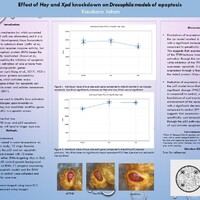Effect of Hay and Xpd knockdown on Drosophila models of apoptosis
Item
Poster Number
30
Poster Title
Effect of Hay and Xpd knockdown on Drosophila models of apoptosis
First Presenter
Kaushara Jahan
Abstract
Apoptosis, or cell death, is a vital component of various processes including normal cell turnover, proper development and functioning of the immune system, and. In a previous study, we examined the natural variation in the Drosophila Genetic Reference Panel (DGRP) on two models of apoptosis, wherein we overexpress the cell death drivers p53 or reaper (rpr). P53 is a tumor suppressor which activates cell cycle arrest, DNA repair, and eventually cell death. Reaper (rpr) is one of the proapoptotic genes induced by p53, and it actively inhibits pathways that normally prevent cell death. Through these preliminary studies, we identified that Xpd and Hay are two candidate modifiers of apoptosis. Xeroderma pigmentosum group D (XPD/ERCC2) is part of a complex that is required for DNA unwinding at the site of DNA damage. Haywire (Hay) is another subunit in the same complex. In previous study, we found that knockdown of Hay and Xpd resulted partial rescue in rpr model induced apoptosis. In p53 models, loss of Hay continued to result in partial rescue, while knockdown of Xpd expression actually enhances apoptosis. In this study, we want to know effect of knockdown of Xpd and Hay on other models of cell death, as well as whether they interact with the pro-apoptotic gene Htra2. High- temperature requirement A2 (Htra2) is a mitochondrial protease. It has been shown that in the presence of apoptotic stimuli, Htra2 binds and cleaves inhibitor of apoptosis protein (IAPs). In this study, we expect to see an increase in apoptosis upon knockdown of Xpd and Hay and overexpression of Htra2, placing Htra2 downstream of Xpd and Hay function.
Year
2022
Embargo
no embargo
